
Gonfalonier of the Church
Encyclopedia
.svg.png)
Italian language
Italian is a Romance language spoken mainly in Europe: Italy, Switzerland, San Marino, Vatican City, by minorities in Malta, Monaco, Croatia, Slovenia, France, Libya, Eritrea, and Somalia, and by immigrant communities in the Americas and Australia...
: Gonfaloniere della Chiesa, "standard-bearer
Standard-bearer
A standard-bearer is a person who bears an emblem called an ensign or standard, i.e. either a type of flag or an inflexible but mobile image, which is used as a formal, visual symbol of a state, prince, military unit, etc.This can either be an occasional duty, often seen as an honour , or a...
"; Latin: Vexillifer Ecclesiæ) was a military and political office of the Papal States
Papal States
The Papal State, State of the Church, or Pontifical States were among the major historical states of Italy from roughly the 6th century until the Italian peninsula was unified in 1861 by the Kingdom of Piedmont-Sardinia .The Papal States comprised territories under...
. Originating from the use of the Papal banner
Gonfalone of the Church
The Banner of the Holy Roman Church was the battle standard of the Papal States during the Renaissance and a symbol of the Roman Catholic Church...
during combat, the office later became largely ceremonial and political. At his nomination, the Gonfalonier was given two banners, one with the arms of the Church (vexillum cum armis Ecclesiæ) and another with the arms of the reigning pope
Pope
The Pope is the Bishop of Rome, a position that makes him the leader of the worldwide Catholic Church . In the Catholic Church, the Pope is regarded as the successor of Saint Peter, the Apostle...
(cum armis suis). The Gonfalonier was entitled to include ecclesiastical emblems (the Keys of St. Peter and the ombrellino) upon his own arms, usually only during his term of office but on occasion permanently. Pope Innocent XII
Pope Innocent XII
Pope Innocent XII , born Antonio Pignatelli, was Pope from 1691 to 1700.-Biography:He was born in Spinazzola to one of the most aristocratic families of the Kingdom of Naples, which included many Viceroys, and ministers to the crown, and was educated at the Jesuit college in Rome.In his twentieth...
ended the rank, along with the captaincy general
Captain General of the Church
The Captain General of the Church was the de facto commander-in-chief of the papal armed forces during the Middle Ages. The post was usually conferred on an Italian noble with a professional military reputation or a relative of the pope...
, and replaced them both with the position of Flag-bearer of the Holy Roman Church (Italian
Italian language
Italian is a Romance language spoken mainly in Europe: Italy, Switzerland, San Marino, Vatican City, by minorities in Malta, Monaco, Croatia, Slovenia, France, Libya, Eritrea, and Somalia, and by immigrant communities in the Americas and Australia...
: Vessilifero di Santo Romana Chiesa), which later became hereditary in the Naro Patrizi.
List of Gonfaloniers of the Church
| Term of office | Portrait | Gonfalonier | Appointing Pope | Notes |
|---|---|---|---|---|
| 1059 — ? | Robert Guiscard Robert Guiscard Robert d'Hauteville, known as Guiscard, Duke of Apulia and Calabria, from Latin Viscardus and Old French Viscart, often rendered the Resourceful, the Cunning, the Wily, the Fox, or the Weasel was a Norman adventurer conspicuous in the conquest of southern Italy and Sicily... |
Nicholas II Pope Nicholas II Pope Nicholas II , born Gérard de Bourgogne, Pope from 1059 to July 1061, was at the time of his election the Bishop of Florence.-Antipope Benedict X:... (1059–1061) |
||
| c. 1118 | Stephen the Norman | With Pier Leoni Pier Leoni Pier Leoni was the son of the Jewish convert Leo de Benedicto and founder of the great and important medieval Roman family of the Pierleoni. He was called the Jewish Crassus by Gregorovius.... , rescued Pope Gelasius II Pope Gelasius II Pope Gelasius II , born Giovanni Caetani , was pope from January 24, 1118 to January 29, 1119.-Biography:He was born between 1060 and 1064 at Gaeta into the Pisan branch of the Caetani family.... from Cencio II Frangipane Cencio II Frangipane Cencius II or Cencio II Frangipane was the son of either of Cencio I or of John, a brother of one Leo. He was the principal representative of the Frangipani family of Rome in the early twelfth century.... . |
||
| c. 1296 | 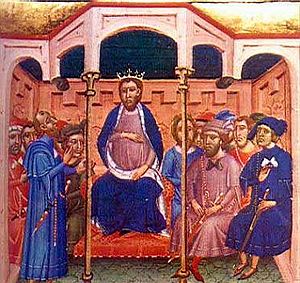 |
James II of Aragon James II of Aragon James II , called the Just was the King of Sicily from 1285 to 1296 and King of Aragon and Valencia and Count of Barcelona from 1291 to 1327. In 1297 he was granted the Kingdom of Sardinia and Corsica... |
Boniface VIII Pope Boniface VIII Pope Boniface VIII , born Benedetto Gaetani, was Pope of the Catholic Church from 1294 to 1303. Today, Boniface VIII is probably best remembered for his feuds with Dante, who placed him in the Eighth circle of Hell in his Divina Commedia, among the Simonists.- Biography :Gaetani was born in 1235 in... (1294–1303) |
King of Aragon and Valencia; Gonfalonier, admiral, and Captain General of the Church Captain General of the Church The Captain General of the Church was the de facto commander-in-chief of the papal armed forces during the Middle Ages. The post was usually conferred on an Italian noble with a professional military reputation or a relative of the pope... ; appointed to encourage him to wage war against his brother Frederick III Frederick III of Sicily Frederick II was the regent and subsequently King of Sicily from 1295 until his death. He was the third son of Peter III of Aragon and served in the War of the Sicilian Vespers on behalf of his father and brothers, Alfonso and James... (c.f. Sicilian Vespers Sicilian Vespers The Sicilian Vespers is the name given to the successful rebellion on the island of Sicily that broke out on the Easter of 1282 against the rule of the French/Angevin king Charles I, who had ruled the Kingdom of Sicily since 1266. Within six weeks three thousand French men and women were slain by... ) |
| 1372 — ? | Galeotto I Malatesta Galeotto I Malatesta Galeotto I Malatesta was an Italian condottiero, who was lord of Rimini, Fano, Ascoli Piceno, Cesena and Fossombrone.-Biography:Born in Rimini, he the son of Pandolfo I Malatesta and the brother of Malatesta II Malatesta. In 1333 he was captured while besieging Ferrara, but was soon freed and... |
Gregory XI Pope Gregory XI Gregory XI was pope from 1370 until his death.-Biography:He was born Pierre Roger de Beaufort, in Maumont, in the modern commune of Rosiers-d'Égletons, Limousin around 1336. He succeeded Pope Urban V in 1370, and was pope until 1378... (1370–1378) |
Commander of the Papal Army against Bernabò Visconti Bernabo Visconti Bernabò Visconti was an Italian soldier and statesman, who was Lord of Milan.-Life:He was born in Milan, the son of Stefano Visconti and Valentina Doria. From 1346 to 1349 he lived in exile, until he was called back by his uncle Giovanni Visconti... , whom he defeated at Montechiaro Montechiaro Montechiaro could refer to:* Montechiaro d'Asti - a town and comune in the Province of Asti, Italy* Montechiaro d'Acqui - a town and comune in the Province of Alessandria, Italy* Palma di Montechiaro - a town and comune of Sicily... . |
|
| 1377 — 1384 | Ridolfo II da Varano di Camerino | Gregory XI Pope Gregory XI Gregory XI was pope from 1370 until his death.-Biography:He was born Pierre Roger de Beaufort, in Maumont, in the modern commune of Rosiers-d'Égletons, Limousin around 1336. He succeeded Pope Urban V in 1370, and was pope until 1378... (1370–1378) |
Appointed by Gregory XI and served as Commander of the Papal Army during the final years of the Avignon Papacy Avignon Papacy The Avignon Papacy was the period from 1309 to 1376 during which seven Popes resided in Avignon, in modern-day France. This arose from the conflict between the Papacy and the French crown.... . |
|
| 1384 — 1385 | .jpg) |
Charles III of Naples Charles III of Naples Charles the Short or Charles of Durazzo was King of Naples and titular King of Jerusalem from 1382 to 1386 as Charles III, and King of Hungary from 1385 to 1386 as Charles II. In 1382 Charles created the order of Argonauts of Saint Nicholas... |
Urban VI Pope Urban VI Pope Urban VI , born Bartolomeo Prignano, was Pope from 1378 to 1389.-Biography:Born in Itri, he was a devout monk and learned casuist, trained at Avignon. On March 21, 1364, he was consecrated Archbishop of Acerenza in the Kingdom of Naples... (1378–1389) |
King of Naples. Excommunicated and removed from office, his forces besieged the pope at Nocera Nocera Inferiore Nocera Inferiore, formerly Nocera dei Pagani, is a town and comune in Campania, Italy, in the province of Salerno, at the foot of Monte Albino, 20 km east-south-east of Naples by rail.-History:... , while the pope later attempted to usurp Naples for his nephew Francesco Moricotti Prignani Francesco Moricotti Prignani was an Italian bishop and Cardinal. A cardinal-nephew, he was created Cardinal in 1378 by his uncle Pope Urban VI.... . |
| 1387 — ? | 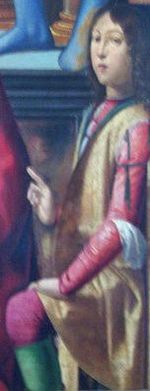 |
Carlo I Malatesta Carlo I Malatesta Carlo I Malatesta was an Italian condottiero during the Wars in Lombardy and lord of Rimini, Fano, Cesena and Pesaro... |
Urban VI Pope Urban VI Pope Urban VI , born Bartolomeo Prignano, was Pope from 1378 to 1389.-Biography:Born in Itri, he was a devout monk and learned casuist, trained at Avignon. On March 21, 1364, he was consecrated Archbishop of Acerenza in the Kingdom of Naples... (1378–1389) |
A condottiero. |
| c. 1399 | 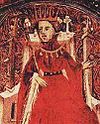 |
Martin of Aragon | Antipope Benedict XIII Antipope Benedict XIII Benedict XIII, born Pedro Martínez de Luna y Pérez de Gotor , known as in Spanish, was an Aragonese nobleman, who is officially considered by the Catholic Church to be an antipope.... |
King of Aragon and Sicily. Gonfalonier of the Western antipope Western Schism The Western Schism or Papal Schism was a split within the Catholic Church from 1378 to 1417. Two men simultaneously claimed to be the true pope. Driven by politics rather than any theological disagreement, the schism was ended by the Council of Constance . The simultaneous claims to the papal chair... , but refused to wage war against France during the siege of Avignon |
| 1403 — ? | Niccolò III d'Este | Boniface IX Pope Boniface IX Pope Boniface IX , born Piero Tomacelli, was the second Roman Pope of the Western Schism from November 2, 1389, until October 1, 1404... (1389–1404) |
A condottiero; also Lord of Ferrara. Appointed in opposition to Milan. Possibly reappointed by Pope Martin V Pope Martin V Pope Martin V , born Odo Colonna, was Pope from 1417 to 1431. His election effectively ended the Western Schism .-Biography:... . |
|
| 1406 — ? | .jpg) |
Ladislaus of Naples | Innocent VII Pope Innocent VII Pope Innocent VII , born Cosimo de' Migliorati, was briefly Pope at Rome, from 1404 to his death, during the Western Schism while there was a rival Pope, antipope Benedict XIII , at Avignon.Migliorati was born to a simple family of Sulmona in the Abruzzi... (1404–1406) |
King of Naples; appointed for his assistance in helping Innocent VII against the Roman mob. Routed at Roccasecca in 1411, he abandoned Pope Gregory XII Pope Gregory XII Pope Gregory XII , born Angelo Correr or Corraro, Pope from 1406 to 1415, succeeded Pope Innocent VII on 30 November 1406.... in favor of the antipope John XXIII Antipope John XXIII Baldassarre Cossa was Pope John XXIII during the Western Schism. The Catholic Church regards him as an antipope.-Biography:... , who appointed him his gonfalonier. |
| 1409 — 1411 | Louis II of Naples Louis II of Naples Louis II of Anjou was the rival of Ladislaus as King of Naples. He was a member of the House of Valois-Anjou.-Biography:... |
Antipope Alexander V Antipope Alexander V Alexander V was antipope during the Western Schism . He reigned from June 26, 1409, to his death in 1410 and is officially regarded by the Roman Catholic Church as an antipope.... |
Opposed to Ladislaus for the Kingdom of Naples Kingdom of Naples The Kingdom of Naples, comprising the southern part of the Italian peninsula, was the remainder of the old Kingdom of Sicily after secession of the island of Sicily as a result of the Sicilian Vespers rebellion of 1282. Known to contemporaries as the Kingdom of Sicily, it is dubbed Kingdom of... , was appointed gonfalonier by the Pisan faction Council of Pisa The Council of Pisa was an unrecognized ecumenical council of the Catholic Church held in 1409 that attempted to end the Western Schism by deposing Benedict XIII and Gregory XII... 's antipope Alexander V Antipope Alexander V Alexander V was antipope during the Western Schism . He reigned from June 26, 1409, to his death in 1410 and is officially regarded by the Roman Catholic Church as an antipope.... . Despite winning a major victory at Roccasecca, though, abandoned the field and returned to France. |
|
| 1412 — ? | Gianfrancisco I Gonzaga Gianfrancesco I Gonzaga, Marquis of Mantua thumb|right|Portrait of Gianfrancesco I Gonzaga, Ambras castle collection, [[Innsbruck]], [[Austria]].Gianfrancesco I Gonzaga was Marquess of Mantua from 1407 to 1444. He was also a condottiero.-Biography:... |
Gregory XII Pope Gregory XII Pope Gregory XII , born Angelo Correr or Corraro, Pope from 1406 to 1415, succeeded Pope Innocent VII on 30 November 1406.... (1406–1415) |
A condottiero; also Lord of Mantua Duchy of Mantua The Duchy of Mantua was a duchy in Lombardy, Northern Italy, subject to the Holy Roman Empire.-History:After the fall of the Western Roman Empire, Mantua was invaded by Byzantines, Longobards and Franks. In the 11th century it became a possession of Boniface of Canossa, marquis of Toscana... . |
|
| 1431 — ? | Niccolò Fortebraccio Niccolò Fortebraccio Niccolò Fortebraccio , also known as Niccolò della Stella, was an Italian condottiero.Born in Sant'Angelo in Vado, he was the son of Stella, sister of Braccio da Montone. His half-brother Oddo and his cousin Carlo were also condottieri.... |
Eugene IV Pope Eugene IV Pope Eugene IV , born Gabriele Condulmer, was pope from March 3, 1431, to his death.-Biography:He was born in Venice to a rich merchant family, a Correr on his mother's side. Condulmer entered the Order of Saint Augustine at the monastery of St. George in his native city... (1431–1447) |
A condottiero; despite his failure to recapture Città di Castello Città di Castello Città di Castello is a city and comune in the province of Perugia, in the northern part of the Umbria region of Italy. It is situated on a slope of the Apennines, on the flood plain of the river Tiber. The city is north of Perugia and south of Cesena on the S3bis. It is connected to the A1... , was hired as Gonfalonier to oppose Sigismund of Hungary Sigismund, Holy Roman Emperor Sigismund of Luxemburg KG was King of Hungary, of Croatia from 1387 to 1437, of Bohemia from 1419, and Holy Roman Emperor for four years from 1433 until 1437, the last Emperor of the House of Luxemburg. He was also King of Italy from 1431, and of Germany from 1411... in Tuscany and the Prefetti di Vico Prefetti di Vico The Prefetti di Vico were an Italian noble family, of German origin, who established in Rome from the 10th century.They obtained the title of praefect urbis by the Holy Roman Emperor. The rest of the name derived from the Lake Vico, in northern Lazio, where most of their lands were located... in Lazio, but fired for using his position to advance his own interests. Thereafter went to war against the Papal States for Milan Duchy of Milan The Duchy of Milan , was created on the 1st of may 1395, when Gian Galeazzo Visconti, Lord of Milan, purchased a diploma for 100,000 Florins from King Wenceslaus. It was this diploma that installed, Gian Galeazzo as Duke of Milan and Count of Pavia... . |
|
| 1433 — 1434 | Giovanni Vitelleschi Giovanni Vitelleschi Giovanni Maria Vitelleschi was an Italian cardinal and condottiere.-Biography:Vitelleschi was born in Corneto , some kilometers north to Rome. He received a military education, which he refined as apostolic protonotary under Pope Martin V... |
Eugene IV Pope Eugene IV Pope Eugene IV , born Gabriele Condulmer, was pope from March 3, 1431, to his death.-Biography:He was born in Venice to a rich merchant family, a Correr on his mother's side. Condulmer entered the Order of Saint Augustine at the monastery of St. George in his native city... (1431–1447) |
Commander of the Papal Armies for a short time under Pope Eugene IV Pope Eugene IV Pope Eugene IV , born Gabriele Condulmer, was pope from March 3, 1431, to his death.-Biography:He was born in Venice to a rich merchant family, a Correr on his mother's side. Condulmer entered the Order of Saint Augustine at the monastery of St. George in his native city... . |
|
| 1434 — 1442 | 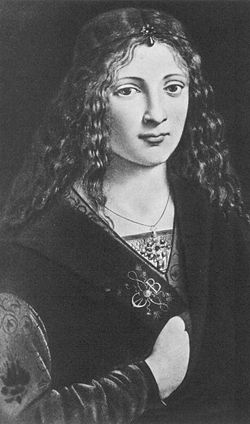 |
Francesco I Sforza Francesco I Sforza Francesco I Sforza was an Italian condottiero, the founder of the Sforza dynasty in Milan, Italy. He was the brother of Alessandro, with whom he often fought.-Early life:... |
Eugene IV Pope Eugene IV Pope Eugene IV , born Gabriele Condulmer, was pope from March 3, 1431, to his death.-Biography:He was born in Venice to a rich merchant family, a Correr on his mother's side. Condulmer entered the Order of Saint Augustine at the monastery of St. George in his native city... (1431–1447) |
A condottiero; while working for Milan, received the position of Gonfalonier along with Ancona March of Ancona The March of Ancona or marca Anconitana was a frontier march centred on the city of Ancona and, then, Macerata in the Middle Ages... as part of the terms of a peace with Eugene, then led the campaign against former Gonfalonier and his former ally Niccolò Fortebraccio. Lost his position after Milan allied with the Papacy against him. |
| 1442 — ? |  |
Niccolò Piccinino Niccolò Piccinino Niccolò Piccinino was an Italian condottiero.-Biography:He was born at Perugia, was the son of a butcher.He began his military career in the service of Braccio da Montone, who at that time was waging war against Perugia on his own account, and at the death of his chief, shortly followed by that of... |
Eugene IV Pope Eugene IV Pope Eugene IV , born Gabriele Condulmer, was pope from March 3, 1431, to his death.-Biography:He was born in Venice to a rich merchant family, a Correr on his mother's side. Condulmer entered the Order of Saint Augustine at the monastery of St. George in his native city... (1431–1447) |
A condottiero. Originally helped Fortebraccio and Sforza against the Papacy, appointed Gonfalonier to recover Sforza's holdings in the Marche March of Ancona The March of Ancona or marca Anconitana was a frontier march centred on the city of Ancona and, then, Macerata in the Middle Ages... . |
| 1444 — ? |  |
Louis, Dauphin of France Louis XI of France Louis XI , called the Prudent , was the King of France from 1461 to 1483. He was the son of Charles VII of France and Mary of Anjou, a member of the House of Valois.... |
Eugene IV Pope Eugene IV Pope Eugene IV , born Gabriele Condulmer, was pope from March 3, 1431, to his death.-Biography:He was born in Venice to a rich merchant family, a Correr on his mother's side. Condulmer entered the Order of Saint Augustine at the monastery of St. George in his native city... (1431–1447) |
Appointed for his actions in Switzerland Switzerland Switzerland name of one of the Swiss cantons. ; ; ; or ), in its full name the Swiss Confederation , is a federal republic consisting of 26 cantons, with Bern as the seat of the federal authorities. The country is situated in Western Europe,Or Central Europe depending on the definition.... against the Council of Basel Council of Florence The Council of Florence was an Ecumenical Council of the Roman Catholic Church. It began in 1431 in Basel, Switzerland, and became known as the Council of Ferrara after its transfer to Ferrara was decreed by Pope Eugene IV, to convene in 1438... and the antipope Felix V Antipope Felix V -External links:*... . |
| c. 1455 | Francesco I Sforza Francesco I Sforza Francesco I Sforza was an Italian condottiero, the founder of the Sforza dynasty in Milan, Italy. He was the brother of Alessandro, with whom he often fought.-Early life:... |
Second term. Now uninvested duke of Milan. | ||
| ? — 1458 | Pedro Luis Borgia Pedro Luis de Borja Pedro Luis de Borja was younger brother of Rodrigo Borgia and nephew of Cardinal Alonso de Borja, who in 1455 became Pope Callixtus III. He was called Don Pedro Luis.... |
Callixtus III Pope Callixtus III Pope Callixtus III , né Alfons de Borja, was Pope from April 8, 1455 to his death in 1458.-Biography:... (1455–1458) |
Pope Callixtus's older brother. Also Captain General Captain General of the Church The Captain General of the Church was the de facto commander-in-chief of the papal armed forces during the Middle Ages. The post was usually conferred on an Italian noble with a professional military reputation or a relative of the pope... and Duke of Spoleto. |
|
| 1462 — 1468 | 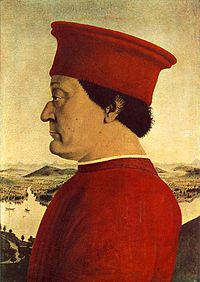 |
Federico da Montefeltro Federico da Montefeltro Federico da Montefeltro, also known as Federico III da Montefeltro , was one of the most successful condottieri of the Italian Renaissance, and lord of Urbino from 1444 until his death... |
Pius II Pope Pius II Pope Pius II, born Enea Silvio Piccolomini was Pope from August 19, 1458 until his death in 1464. Pius II was born at Corsignano in the Sienese territory of a noble but decayed family... (1458–1464) |
A condottiero; also Conte di Urbino. Appointed against Sigismondo Malatesta, lord of Rimini Rimini Rimini is a medium-sized city of 142,579 inhabitants in the Emilia-Romagna region of Italy, and capital city of the Province of Rimini. It is located on the Adriatic Sea, on the coast between the rivers Marecchia and Ausa... . Originally reappointed by Pope Paul II Pope Paul II Pope Paul II , born Pietro Barbo, was pope from 1464 until his death in 1471.- Early life :He was born in Venice, and was a nephew of Pope Eugene IV , through his mother. His adoption of the spiritual career, after having been trained as a merchant, was prompted by his uncle's election as pope... to oppose Venice Republic of Venice The Republic of Venice or Venetian Republic was a state originating from the city of Venice in Northeastern Italy. It existed for over a millennium, from the late 7th century until 1797. It was formally known as the Most Serene Republic of Venice and is often referred to as La Serenissima, in... , but challenged in his acquisition of Rimini following the victory at Molinella, switched sides. |
| 1474 — ? | Federico da Montefeltro Federico da Montefeltro Federico da Montefeltro, also known as Federico III da Montefeltro , was one of the most successful condottieri of the Italian Renaissance, and lord of Urbino from 1444 until his death... |
Sixtus IV Pope Sixtus IV Pope Sixtus IV , born Francesco della Rovere, was Pope from 1471 to 1484. His accomplishments as Pope included the establishment of the Sistine Chapel; the group of artists that he brought together introduced the Early Renaissance into Rome with the first masterpiece of the city's new artistic age,... (1471–1484) |
Second term. Now styled Duke of Urbino; married his daughter to Pope Sixtus's favorite nephew Giovanni della Rovere Giovanni della Rovere was an Italian condottiero and member of the Della Rovere family. He was a nephew of Pope Sixtus IV, and the brother of Giuliano della Rovere , elected to the papal throne as Pope Julius II in 1503.... , who inherited the duchy following the death of Federico's own son Guidobaldo da Montefeltro thumb|240px|Portrait of Guidobaldo da Montefeltro by [[Raphael]].Guidobaldo da Montefeltro , also known as Guidobaldo I, was an Italian condottiero and the Duke of Urbino from 1482 to 1508.-Biography:... . |
|
| 1496 — 1497 |  |
Giovanni Borgia Giovanni Borgia (1474) Giovanni Borgia, 2nd duke of Gandía was the son of Pope Alexander VI and the brother of Cesare Borgia, Gioffre Borgia, and Lucrezia Borgia. Giovanni, also known as Juan or Joan, was the second of the Pope's four children by Vanozza de' Catanei... |
Alexander VI Pope Alexander VI Pope Alexander VI , born Roderic Llançol i Borja was Pope from 1492 until his death on 18 August 1503. He is one of the most controversial of the Renaissance popes, and his Italianized surname—Borgia—became a byword for the debased standards of the Papacy of that era, most notoriously the Banquet... (1492–1503) |
Son; also Duke of Gandia Duke of Gandia The hereditary Spanish title duke of Gandía was created in 1485 by Ferdinand II of Aragon from the original Italian title "duke of Candia" belonging to the Italian Stato di Mare or Italian Kingdoms of the Mediterranean Sea; originally granted around 1206 to a Genoan marquis member of the House of... and Captain General Captain General of the Church The Captain General of the Church was the de facto commander-in-chief of the papal armed forces during the Middle Ages. The post was usually conferred on an Italian noble with a professional military reputation or a relative of the pope... ; assassinated, perhaps by his brother Cesare |
| 29 March 1500 — 1503 | 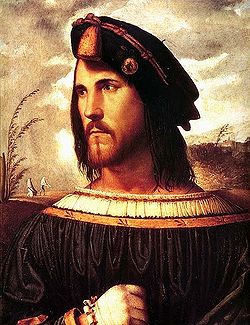 |
Cesare Borgia Cesare Borgia Cesare Borgia , Duke of Valentinois, was an Italian condottiero, nobleman, politician, and cardinal. He was the son of Pope Alexander VI and his long-term mistress Vannozza dei Cattanei. He was the brother of Lucrezia Borgia; Giovanni Borgia , Duke of Gandia; and Gioffre Borgia , Prince of Squillace... |
Alexander VI Pope Alexander VI Pope Alexander VI , born Roderic Llançol i Borja was Pope from 1492 until his death on 18 August 1503. He is one of the most controversial of the Renaissance popes, and his Italianized surname—Borgia—became a byword for the debased standards of the Papacy of that era, most notoriously the Banquet... (1492–1503) |
Son; former cardinal, also Duke of Valentino and Captain General Captain General of the Church The Captain General of the Church was the de facto commander-in-chief of the papal armed forces during the Middle Ages. The post was usually conferred on an Italian noble with a professional military reputation or a relative of the pope... ; often accused of Giovanni's assassination, either directly or indirectly. Julius II Pope Julius II Pope Julius II , nicknamed "The Fearsome Pope" and "The Warrior Pope" , born Giuliano della Rovere, was Pope from 1503 to 1513... refused to confirm Cesare upon his election. |
| 1504 — 1508? | Guidobaldo da Montefeltro Guidobaldo da Montefeltro thumb|240px|Portrait of Guidobaldo da Montefeltro by [[Raphael]].Guidobaldo da Montefeltro , also known as Guidobaldo I, was an Italian condottiero and the Duke of Urbino from 1482 to 1508.-Biography:... |
Julius II Pope Julius II Pope Julius II , nicknamed "The Fearsome Pope" and "The Warrior Pope" , born Giuliano della Rovere, was Pope from 1503 to 1513... (1503–1513) |
A condottiero; also Duke of Urbino. Son of Federico da Montefeltro; adopted Francesco Maria I della Rovere Francesco Maria I della Rovere Francesco Maria I della Rovere was an Italian condottiero, who was Duke of Urbino from 1508 until 1538.- Biography :... , his nephew and the pope's. |
|
| 19 April 1509 — 1510 | Alfonso I d'Este | Julius II Pope Julius II Pope Julius II , nicknamed "The Fearsome Pope" and "The Warrior Pope" , born Giuliano della Rovere, was Pope from 1503 to 1513... (1503–1513) |
Also Duke of Ferrara. Commanded forces against Venice Republic of Venice The Republic of Venice or Venetian Republic was a state originating from the city of Venice in Northeastern Italy. It existed for over a millennium, from the late 7th century until 1797. It was formally known as the Most Serene Republic of Venice and is often referred to as La Serenissima, in... during the second phase of the War of the League of Cambrai War of the League of Cambrai The War of the League of Cambrai, sometimes known as the War of the Holy League and by several other names, was a major conflict in the Italian Wars... . Removed from his post and excommunicated with all his family in order to return Ferrara to direct Papal administration. |
|
| 30 September 1510 — ? | 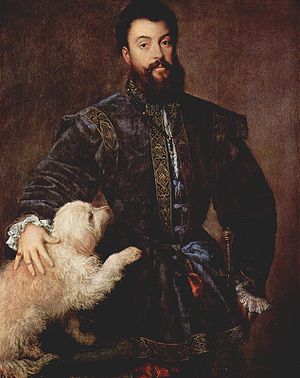 |
Federico II Gonzaga | Julius II Pope Julius II Pope Julius II , nicknamed "The Fearsome Pope" and "The Warrior Pope" , born Giuliano della Rovere, was Pope from 1503 to 1513... (1503–1513) |
Also Duke of Mantua and Captain General Captain General of the Church The Captain General of the Church was the de facto commander-in-chief of the papal armed forces during the Middle Ages. The post was usually conferred on an Italian noble with a professional military reputation or a relative of the pope... both of the Church and of Venice. Was not required to oppose the Holy Roman Empire Holy Roman Empire The Holy Roman Empire was a realm that existed from 962 to 1806 in Central Europe.It was ruled by the Holy Roman Emperor. Its character changed during the Middle Ages and the Early Modern period, when the power of the emperor gradually weakened in favour of the princes... and so failed to intervene in the Sack of Rome Sack of Rome (1527) The Sack of Rome on 6 May 1527 was a military event carried out by the mutinous troops of Charles V, Holy Roman Emperor in Rome, then part of the Papal States... |
| 1513 — 1516 | 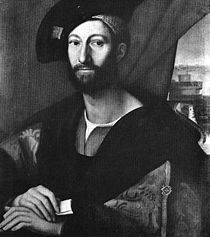 |
Giuliano de'Medici | Leo X Pope Leo X Pope Leo X , born Giovanni di Lorenzo de' Medici, was the Pope from 1513 to his death in 1521. He was the last non-priest to be elected Pope. He is known for granting indulgences for those who donated to reconstruct St. Peter's Basilica and his challenging of Martin Luther's 95 Theses... (1513–1521) |
Also Captain General Captain General of the Church The Captain General of the Church was the de facto commander-in-chief of the papal armed forces during the Middle Ages. The post was usually conferred on an Italian noble with a professional military reputation or a relative of the pope... and Duke of Nemours Duke of Nemours In the 12th and 13th centuries the Lordship of Nemours, in the Gatinais, France, was in possession of the house of Villebeon, a member of which, Gautier, was marshal of France in the middle of the 13th century... . |
| 1516 — ? |  |
Lorenzo II de'Medici | Leo X Pope Leo X Pope Leo X , born Giovanni di Lorenzo de' Medici, was the Pope from 1513 to his death in 1521. He was the last non-priest to be elected Pope. He is known for granting indulgences for those who donated to reconstruct St. Peter's Basilica and his challenging of Martin Luther's 95 Theses... (1513–1521) |
Also Captain General Captain General of the Church The Captain General of the Church was the de facto commander-in-chief of the papal armed forces during the Middle Ages. The post was usually conferred on an Italian noble with a professional military reputation or a relative of the pope... : commanded the papal army in the War of Urbino War of Urbino The War of Urbino was a secondary episode of the Italian Wars.The conflict ensued after the end of the War of the League of Cambrai , when Francesco Maria I della Rovere decided to take advantage of the situation to recover the Duchy of Urbino, from which he had been ousted in the previous year.In... (1517), before being wounded at the siege of Mondolfo Mondolfo Mondolfo is a comune in the Province of Pesaro e Urbino in the Italian region Marche, located about 35 km northwest of Ancona and about 25 km southeast of Pesaro, on the Adriatic Sea... |
| 1 February 1537 — 1547 | Pier Luigi Farnese Pier Luigi Farnese, Duke of Parma Pier Luigi Farnese was the first Duke of Parma, Piacenza and Castro, from 1545 to 1547.Born in Rome, Pier Luigi was the illegitimate son of Cardinal Alessandro Farnese... |
Paul III Pope Paul III Pope Paul III , born Alessandro Farnese, was Pope of the Roman Catholic Church from 1534 to his death in 1549. He came to the papal throne in an era following the sack of Rome in 1527 and rife with uncertainties in the Catholic Church following the Protestant Reformation... (1534–1549) |
Son of Paul III; also Duke of Parma, Piacenza, and Castro. | |
| 1547 — 1551 | Ottavio Farnese Ottavio Farnese, Duke of Parma Ottavio Farnese reigned as Duke of Parma and Piacenza from 1547 and Duke of Castro from 1545 until his death.-Biography:... |
Paul III Pope Paul III Pope Paul III , born Alessandro Farnese, was Pope of the Roman Catholic Church from 1534 to his death in 1549. He came to the papal throne in an era following the sack of Rome in 1527 and rife with uncertainties in the Catholic Church following the Protestant Reformation... (1534–1549) |
Son of Pier Luigi Farnese; also Duke of Parma, Piacenza, and Castro | |
| c. 1565 | Jacques Annibal de Hohenembs | (or Count Hannibal of Altemps.) | ||
| 1566 — ? | Ottavio Farnese Ottavio Farnese, Duke of Parma Ottavio Farnese reigned as Duke of Parma and Piacenza from 1547 and Duke of Castro from 1545 until his death.-Biography:... |
Pius V Pope Pius V Pope Saint Pius V , born Antonio Ghislieri , was Pope from 1566 to 1572 and is a saint of the Catholic Church. He is chiefly notable for his role in the Council of Trent, the Counter-Reformation, and the standardization of the Roman liturgy within the Latin Church... (1566–1572) |
Second term. | |
| 1572 — 1585 | Giacomo Boncompagni Giacomo Boncompagni Giacomo Boncompagni was an Italian feudal lord of the 16th century, the illegitimate son of Pope Gregory XIII . He was also Duke of Sora, Aquino, Arce and Arpino, and Marquess of Vignola.A member of the Boncompagni family, he was a patron of arts and culture... |
Gregory XIII Pope Gregory XIII Pope Gregory XIII , born Ugo Boncompagni, was Pope from 1572 to 1585. He is best known for commissioning and being the namesake for the Gregorian calendar, which remains the internationally-accepted civil calendar to this date.-Youth:He was born the son of Cristoforo Boncompagni and wife Angela... (1572–1585) |
Son; also Captain General of Spanish Milan, purchased the Duchies of Sora and Arce Duchy of Sora The Duchy of Sora was a semi-independent state in Italy, created in 1443 by King Alfonso I of Naples and dissolved in 1796. It occupied the south-eastern part of what is today Lazio, bordering what is now Abruzzo... , Aquino and Arpino. Removed as Gonfalonier upon the election of Pope Sixtus V Pope Sixtus V Pope Sixtus V , born Felice Peretti di Montalto, was Pope from 1585 to 1590.-Early life:The chronicler Andrija Zmajević states that Felice's family originated from modern-day Montenegro... . |
|
| c.1621 — ? | Odoardo Farnese Odoardo Farnese Odoardo Farnese was Duke of Parma and Piacenza from 1622 to 1646.-Biography:Odoardo was the sole legitimate son of Ranuccio I Farnese and Margherita Aldobrandini... |
Gregory XV Pope Gregory XV Pope Gregory XV , born Alessandro Ludovisi, was pope from 1621, succeeding Paul V on 9 February 1621... (1621–1623) |
Also Duke of Parma and Piacenza. Excommunicated and prohibited from use of Gonfalonier emblems by Pope Urban VIII Pope Urban VIII Pope Urban VIII , born Maffeo Barberini, was pope from 1623 to 1644. He was the last pope to expand the papal territory by force of arms, and was a prominent patron of the arts and reformer of Church missions... . |
|
| ? — 1630 | Carlo Barberini | Urban VIII Pope Urban VIII Pope Urban VIII , born Maffeo Barberini, was pope from 1623 to 1644. He was the last pope to expand the papal territory by force of arms, and was a prominent patron of the arts and reformer of Church missions... (1623–1644) |
Brother of Pope Urban VIII Pope Urban VIII Pope Urban VIII , born Maffeo Barberini, was pope from 1623 to 1644. He was the last pope to expand the papal territory by force of arms, and was a prominent patron of the arts and reformer of Church missions... and Antonio Marcello Barberini Antonio Marcello Barberini Antonio Marcello Barberini was an Italian cardinal and the younger brother of Maffeo Barberini, later Pope Urban VIII. He is sometimes referred to as Antonio the Elder to distinguish him from his nephew Antonio Barberini.Born Marcello Barberini in Florence into the Barberini family, he entered the... . Father of Taddeo Barberini Taddeo Barberini Taddeo Barberini was an Italian nobleman of the House of Barberini who became Prince of Palestrina and Gonfalonier of the Church; commander of the Papal Army. He was a nephew of Pope Urban VIII and brother of Cardinals Francesco Barberini and Antonio Barberini... . |
|
| 1630 — 1636(?) | Torquato Conti Torquato Conti Torquato Conti was an Italian military commander who served as a General-Field Marshal of the Holy Roman Empire during the Thirty Years War. His barbarous treatment of defenceless villagers earned him the nickname, The Devil... |
Urban VIII Pope Urban VIII Pope Urban VIII , born Maffeo Barberini, was pope from 1623 to 1644. He was the last pope to expand the papal territory by force of arms, and was a prominent patron of the arts and reformer of Church missions... (1623–1644) |
Duke of Guadagnolo Monti Prenestini The Monti Prenestini is a mountain range in the Lazio sub-Apennines, in central Italy to the east of Rome. It is of limestone formation. It is bounded by the Monti Tiburtini to the north, by the Monti Ruffi to the east, and by the valley of the river Sacco to the south. The highest peak is Monte... and Field Marshal of the Holy Roman Empire Generalfeldmarschall Field Marshal or Generalfeldmarschall in German, was a rank in the armies of several German states and the Holy Roman Empire; in the Austrian Empire, the rank Feldmarschall was used... |
|
| 1639 — 1644 | Taddeo Barberini Taddeo Barberini Taddeo Barberini was an Italian nobleman of the House of Barberini who became Prince of Palestrina and Gonfalonier of the Church; commander of the Papal Army. He was a nephew of Pope Urban VIII and brother of Cardinals Francesco Barberini and Antonio Barberini... |
Urban VIII Pope Urban VIII Pope Urban VIII , born Maffeo Barberini, was pope from 1623 to 1644. He was the last pope to expand the papal territory by force of arms, and was a prominent patron of the arts and reformer of Church missions... (1623–1644) |
Nephew of Pope Urban VIII Pope Urban VIII Pope Urban VIII , born Maffeo Barberini, was pope from 1623 to 1644. He was the last pope to expand the papal territory by force of arms, and was a prominent patron of the arts and reformer of Church missions... and Prince of Palestrina Palestrina Palestrina is an ancient city and comune with a population of about 18,000, in Lazio, c. 35 km east of Rome... . Appointed Commander of the Papal Army during the Wars of Castro Wars of Castro The Wars of Castro is a term referring to a series of events in the mid-17th century revolving around the ancient city of Castro , which eventually resulted in the city's destruction on 2 September 1649... . Went into exile after the 1644 election of Pope Innocent X Pope Innocent X Pope Innocent X , born Giovanni Battista Pamphilj , was Pope from 1644 to 1655. Born in Rome of a family from Gubbio in Umbria who had come to Rome during the pontificate of Pope Innocent IX, he graduated from the Collegio Romano and followed a conventional cursus honorum, following his uncle... and died, without returning to Rome, in 1647. Dates are approximate. |
|
| 1649 — ? | Maffeo Barberini | Innocent X Pope Innocent X Pope Innocent X , born Giovanni Battista Pamphilj , was Pope from 1644 to 1655. Born in Rome of a family from Gubbio in Umbria who had come to Rome during the pontificate of Pope Innocent IX, he graduated from the Collegio Romano and followed a conventional cursus honorum, following his uncle... (1644–1655) |
Son of Taddeo Barberini Taddeo Barberini Taddeo Barberini was an Italian nobleman of the House of Barberini who became Prince of Palestrina and Gonfalonier of the Church; commander of the Papal Army. He was a nephew of Pope Urban VIII and brother of Cardinals Francesco Barberini and Antonio Barberini... who was appointed to his father's previous titles after the reconciliation of the Pamphili Pamphili The Pamphili are one of the papal families deeply entrenched in Roman Catholic Church, Roman and Italian politics of the 16th and 17th centuries .... and Barberini Barberini The Barberini are a family of the Italian nobility that rose to prominence in 17th century Rome. Their influence peaked with the election of Cardinal Maffeo Barberini to the papal throne in 1623, as Pope Urban VIII... families. |

